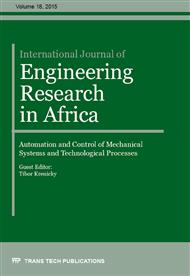[1]
C.D. Ahrens, Meteorology today: an introduction to weather, climate and the environment, 9th ed., Briiks/Cole, California, (2008).
Google Scholar
[2]
J. Bila, Processing of Emergent Phenomena in Complex Systems, International Journal of Enhanced Research in Science Technology and Engineering, Vol. 3, No. 7, (2014), 1-17.
Google Scholar
[3]
Bila, J., I. Bukovsky, Qualitative Models for the Landscape Development Monitoring, Journal for Communication and Computer 9/6 (2012) 721-728.
Google Scholar
[4]
J. Bila, J. Jura, J. Pokorny, I. Bukovsky, Qualitative Modeling and Monitoring of Selected Ecosystem Functions, Ecological Modeling 222 (2011) 3640-3650.
DOI: 10.1016/j.ecolmodel.2011.08.002
Google Scholar
[5]
J. Bila, I. Bukovsky, Modeling and Interpretation of New Solutions in Problem Solving, in: Proc. 12th Int. Carpathian Control Conf. (ICCC), Velke Karlovice, Czech Rep., 2011, pp.22-27.
DOI: 10.1109/carpathiancc.2011.5945808
Google Scholar
[6]
J. Bila, Detection of Emergent Situations by Structural Invariants, in: Proc. 13th Int. Conf. on Soft Computing – Mendel 2011, Brno, Czech Republic, 2010, pp.495-501.
Google Scholar
[7]
J.H. Boose, Expertise Transfer for Expert System Design. Elsevier, Amsterdam, (1986).
Google Scholar
[8]
G.B. Bonan, Forests and climate change: Forcings, feedbacks, and the climate benefits of forests, Science 320 (2008) 1444-1449.
DOI: 10.1126/science.1155121
Google Scholar
[9]
L. Breuer, K. Ekchardt, H.G. Frede, Plant parameters values for models in temperate climates, Ecological Modeling 169 (2003) 237-293.
DOI: 10.1016/s0304-3800(03)00274-6
Google Scholar
[10]
I. Bukovsky, Learning Entropy: Multiscale Measure for Incremental Learning, Entropy 15 (2013) 4159-4187.
DOI: 10.3390/e15104159
Google Scholar
[11]
M. Dohnal, Landfills multiply goal optimization using equationless qualitative relations, American Journal of Environmental Sciences 10/1 (2014) 26-34.
DOI: 10.3844/ajessp.2014.26.34
Google Scholar
[12]
C.L. Elzinga, D.W. Salzer, J.W. Willougby, J.P. Gibbs Monitoring Plant and Animal Populations, Blackwell Science, Massachussetts, (2001).
Google Scholar
[13]
R.D. Klauber, Evolution and Earth's entropy, American Journal of Physics 77/9 (2009) 773-773.
Google Scholar
[14]
B. Koska, Calibration of Profile Laser Scanner with Conical Shape Modification for Autonomous Mapping System, in: Proc. SPIE 8791A, Videometrics, Range Imaging, and Applications 12 (2013).
DOI: 10.1117/12.2020682
Google Scholar
[15]
B. Koska, T. Kremen, M. Stroner, J. Pospisil, V. Jirka, Land drainage system detection using IR and visual imaginary taken from autonomous mapping airship and evaluation of physical and spatial parameters of suggested method, in: Proc. of 16th Remote Sensing for Agriculture, Ecosystems, and Hydrology, SPIE, Bellingham, (2014).
DOI: 10.1117/12.2067148
Google Scholar
[16]
C. Larguet, M.O. Cordier, G. Fontenelle, Scenario templates to analyze qualitative ecosystem models, in: Proc. 18th World IMACS/MODSIM Congress, Cairns, Australia, 13-17 July, 2009, pp.2129-2136.
Google Scholar
[17]
R. Leitch, Q. Shen, Fuzzy Qualitative Simulation, IEEE Trans. On Syst., Man and Cybernet. 4 (1993) 1038-1061.
DOI: 10.1109/21.247887
Google Scholar
[18]
L. Loiselle, L. Bracchini, C. Bonechi, C. Rossi, Modeling energy fluxes in remote wetland ecosystems with help of remote sensing, Ecol. Model. 145 (2001) 243-261.
DOI: 10.1016/s0304-3800(01)00394-5
Google Scholar
[19]
B.R. Noon, Conceptual issues in monitoring ecological systems, in: D.E. Bush and J.C. Trexler (Eds. ); Monitoring Ecosystems: Interdisciplinary Approaches for evaluating Ecoregional Initiatives, Island Press, Washington DC, 2002, pp.27-71.
DOI: 10.5751/es-00511-070201
Google Scholar
[20]
N.J. Nillson, Artificial Intelligence: A New Synthesis, Morgan Kaufmann Publishers, San Francisco, California, USA, (1998).
Google Scholar
[21]
M. Novak, Inference module for the modeling of micrometeorological states in an ecosystem - Thesis, Faculty of Mechanical Engineering, Czech Technical University in Prague, (2014).
Google Scholar
[22]
H.T. Odum, Explanation of ecological relationships with energy systems concepts, Ecol. Model. 158 (2002) 201-211.
Google Scholar
[23]
J.G. Oxley, Matroid Theory, Oxford Science Publications, Oxford, (2001).
Google Scholar
[24]
F. Villa, I. Athanasiadis, A. Rizzoli, Modeling with knowledge: a review of emerging semantic approaches to environmental modeling, Environ. Model. Software 24 (2009) 577-587.
DOI: 10.1016/j.envsoft.2008.09.009
Google Scholar
[25]
F.M. Viola, S.L.D. Paiva, M.A. Savi, Analysis of the global warming dynamics from temperature time series, Ecol. Model. 221 (2010) 1964-(1978).
DOI: 10.1016/j.ecolmodel.2010.05.001
Google Scholar
[26]
L. Wise, A.G. Murta, J.P. Carvalho, M. Mesquita, Qualitative modeling of fishermen's behavior in a pelagic fishery, Ecol. Model. 228 (2012) 112–122.
DOI: 10.1016/j.ecolmodel.2011.12.008
Google Scholar


